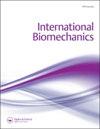爆发力动作中下肢运动链的简单分析应用范例:以击剑箭步为例
Q2 Medicine
引用次数: 4
摘要
一种简单的方法来量化运动链的推进任务将有助于评估运动员的有效性。这项研究的目的是评估运动链是否能区分不同的技能水平。击剑运动员根据攻击弓步能力分为两组(熟练7人;8新手)。获得了攻击弓步推进阶段的后腿三维关节角伸展速度大小和时间、剑运动学和后腿动力学。熟练的击剑运动员获得了更高的剑速(3.24±0.24 m∙s−1 vs. 2.69±0.29 m∙s−1);P = 0.02)。熟练组髋关节、膝关节和踝关节的顺序运动链更大,表现为踝关节角速度显著增加(9.1±2.1 rad·s−1熟练组;5.4±2.9 rad·s−1新手)。踝关节跖屈曲速度与水平峰值力呈显著正相关(r = 0.81;P < 0.01)。熟练组表现出更大的水平冲量(1.85±0.29 N·s·kg−1熟练;1.45±0.32 N·s·kg−1新手),表明运动链应用于水平推进更有效。运动链的分析能够区分推进任务中的技能水平,是评估全肢体对推进运动贡献的一种有效而简单的范例。本文章由计算机程序翻译,如有差异,请以英文原文为准。
An applied paradigm for simple analysis of the lower limb kinematic chain in explosive movements: an example using the fencing foil attacking lunge
Abstract A simple method to quantify the kinematic chain in a propulsive task would facilitate assessment of athlete effectiveness. The study’s aim was to assess if the kinematic chain distinguishes between skill levels. Fencers were separated into two groups based on attacking lunge ability (7 skilled; 8 novices). Rear leg 3D joint angular extension velocity magnitudes and timings, sword kinematics and rear leg kinetics were obtained in the propulsion phase of the attacking lunge. Skilled fencers obtained greater sword velocity (3.24 ± 0.24 m∙s−1 vs. 2.69 ± 0.29 m∙s−1; p = 0.02). The skilled group had a greater sequential kinematic chain of the hip, knee and ankle, demonstrated by significantly greater ankle angular velocity (9.1 ± 2.1 rad·s−1 skilled; 5.4 ± 2.9 rad·s−1 novice). Ankle plantarflexion velocity showed a strong positive correlation with horizontal peak force (r = 0.81; p < 0.01). The skilled group demonstrated greater horizontal impulse (1.85 ± 0.29 N·s·kg−1 skilled; 1.45 ± 0.32 N·s·kg−1 novice), suggesting greater effectiveness in applying the kinematic chain towards horizontal propulsion. Analysis of the kinematic chain, which was able to distinguish between skill levels in a propulsive task, is an effective and simple paradigm to assess whole limb contributions to propulsive movements.
求助全文
通过发布文献求助,成功后即可免费获取论文全文。
去求助
来源期刊

International Biomechanics
Medicine-Rehabilitation
CiteScore
1.90
自引率
0.00%
发文量
2
审稿时长
17 weeks
期刊介绍:
International Biomechanics is a fully Open Access biomechanics journal that aims to foster innovation, debate and collaboration across the full spectrum of biomechanics. We publish original articles, reviews, and short communications in all areas of biomechanics and welcome papers that explore: Bio-fluid mechanics, Continuum Biomechanics, Biotribology, Cellular Biomechanics, Mechanobiology, Mechano-transduction, Tissue Mechanics, Comparative Biomechanics and Functional Anatomy, Allometry, Animal locomotion in biomechanics, Gait analysis in biomechanics, Musculoskeletal and Orthopaedic Biomechanics, Cardiovascular Biomechanics, Plant Biomechanics, Injury Biomechanics, Impact Biomechanics, Sport and Exercise Biomechanics, Kinesiology, Rehabilitation in biomechanics, Quantitative Ergonomics, Human Factors engineering, Occupational Biomechanics, Developmental Biomechanics.
 求助内容:
求助内容: 应助结果提醒方式:
应助结果提醒方式:


